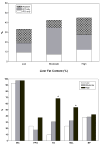Glucose dysregulation and hepatic steatosis in obese adolescents: is there a link?
- PMID: 19434725
- PMCID: PMC2692562
- DOI: 10.1002/hep.22858
Glucose dysregulation and hepatic steatosis in obese adolescents: is there a link?
Abstract
Fatty liver is increasingly common in obese adolescents. We determined its association with glucose dysregulation in 118 (37M/81F) obese adolescents of similar age and percent total fat. Fast-magnetic resonance imaging (MRI) and simple MRI were used to quantify hepatic fat content and abdominal fat distribution. All subjects had a standard oral glucose tolerance test. Insulin sensitivity was estimated by the Matsuda Index and homeostasis model assessment of insulin resistance. Baseline total and high molecular weight (HMW)-adiponectin and interleukin (IL)-6 levels were measured. The cohort was stratified according to tertiles of hepatic fat content. Whereas age and %fat were comparable across tertiles, ethnicity differed in that fewer Blacks and more Whites and Hispanics were in the moderate and high category of hepatic fat fraction (HFF). Visceral and the visceral-to-subcutaneous fat ratio increased and insulin sensitivity decreased across tertiles. Two-hour plasma glucose rose with increasing hepatic steatosis (P < 0.008). 73.7% of the subjects in the high HFF had the metabolic syndrome compared to 19.5% and 30.6%, respectively, in the low and moderate categories. Both total and HMW-adiponectin decreased, and IL-6 increased with increasing hepatic steatosis.
Conclusion: In obese adolescents, independent of total fat, increasing severity of fatty liver is associated with glucose dysregulation, metabolic syndrome, and with a proinflammatory milieu.
Figures


Comment in
-
Utility of magnetic resonance imaging in the evaluation of hepatic fat content.Hepatology. 2009 Jul;50(1):328-9; author reply 329. doi: 10.1002/hep.23039. Hepatology. 2009. PMID: 19496178 No abstract available.
References
-
- Burgert TS, Taksali SE, Dziura J, Goodman TR, Yeckel CW, Papademetris X, et al. Alanine aminotransferase levels and fatty liver in childhood obesity: associations with insulin resistance, adiponectin, and visceral fat. J Clin Endocrinol Metab. 2006 Nov;91(11):4287–4294. - PubMed
-
- Nadeau KJ, Klingensmith G, Zeitler P. Type 2 diabetes in children is frequently associated with elevated alanine aminotransferase. J Pediatr Gastroenterol Nutr. 2005 Jul 1;41:94–98. - PubMed
-
- Angulo P. Nonalcoholic fatty liver disease. N Engl J Med. 2002 Apr 18;346(16):1221–1231. - PubMed
Publication types
MeSH terms
Substances
Grants and funding
LinkOut - more resources
Full Text Sources
Medical
